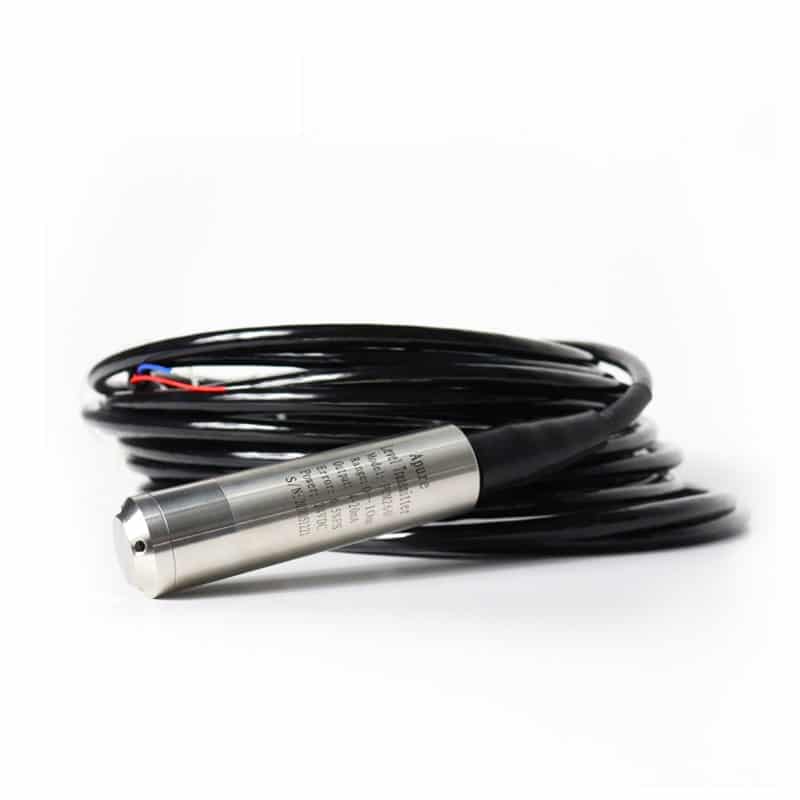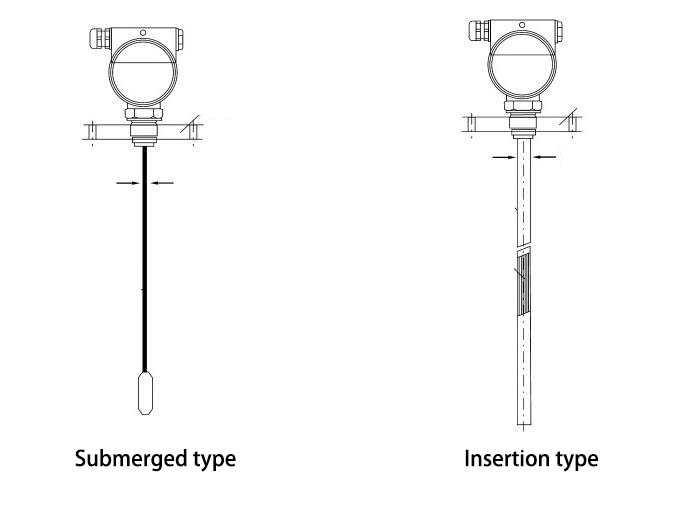Capacitive level sensors are an extremely valuable technology when it comes to fluid management and liquid level monitoring. These advanced sensors are used in a wide range of industrial and commercial applications because they not only accurately measure the height of liquids, but also enable monitoring without touching the liquid.
Working principle of capacitive level sensors
Capacitance level sensors utilize the principle of capacitance to measure the height or level change of a liquid. Its basic construction consists of a detection electrode and an excitation electrode that introduces current. Here is how it works:


Principle overview
- Capacitance change in relation to liquid level:
A capacitor is formed between the detection electrodes in the sensor and the liquid. The size of the capacitance is related to the distance between the electrodes, the dielectric constant of the liquid and the height of the liquid. When the liquid level changes, the capacitance value of the capacitor will change accordingly. - Excitation electrode:
In addition to the detection electrode, the sensor contains an excitation electrode that is used to generate an electric field. This electric field affects the capacitance value between the detection electrode and the liquid.
Workflow
- Capacitance value measurement:
After the electric field is introduced through the excitation electrode, the capacitance value between the detection electrode and the liquid is measured. As the liquid level changes, the capacitance value also changes. - Conversion to liquid level information:
The sensor converts the measured capacitance value into corresponding liquid level height information. This information may be processed by an internal signal processor or converter, and ultimately converted into readable level data or an output signal.
What does a capacitive level sensor consist of?
- Detection electrode:
This is one of the key components in the sensor. The probe electrode is responsible for forming a capacitance with the liquid, and its shape and choice of material usually affects the performance and accuracy of the sensor. It is located next to or inside the liquid and forms a capacitance with the liquid. - Excitation electrode:
In addition to the detection electrode, capacitive level sensors usually contain an excitation electrode, which is used to generate an electric field or introduce a current. The function of the excitation electrode is to generate an electric field between the detection electrode and the liquid, which affects the change of capacitance. - Signal processing unit:
The sensor is usually equipped with a signal processor or converter that processes the capacitance change data obtained from the detection electrode. It converts the capacitance change into readable level information or an output signal. - connectors and housings:
The sensor also includes connectors and housings to protect the internal components of the sensor and to provide appropriate connection interfaces for use in connection with other equipment or systems.
What are the types of capacitive sensors?
Capacitive level sensors are usually divided into two types: insertion and immersion.
Insertion type liquid level sensor:
- Working principle: This type of sensor measures the liquid level height by inserting the probe into the liquid. The probe generally consists of electrodes, when the liquid level touches the electrodes, a capacitive change occurs, the sensor measures this change and outputs the corresponding signal.
- Application: Commonly used inside smaller vessels or pipelines, the level height is measured by inserting the sensor directly into the liquid.
Submerged liquid level sensor:
- Working principle: this type of sensor measures the liquid level height by completely immersing the sensor itself into the liquid, without the need for a special insertion probe.
- Application: suitable for deeper liquids, can be placed directly in the liquid to measure the height of the entire liquid layer, commonly used in deep wells, tanks or liquid storage tanks and other occasions.

What is the signal processing unit of a capacitive level sensor?
The signal processing unit of a capacitive level sensor is usually a circuit board or module that processes the capacitance changes captured by the sensor and converts them into a usable electrical signal. This unit consists of the following main components:
- Signal conditioning circuitry: Used to amplify and filter the small capacitance changes captured by the sensor so that they become easier to measure and understand.
- Analog-to-digital converter (ADC): converts analog capacitance signals into digital signals for further processing or transmission by digital systems.
- Microprocessor or processing unit: Performs signal processing and data analysis, which may include filtering, calibrating, and temperature compensation of the signal.
- Communication interface: Allows the sensor to communicate with other devices or systems, such as a serial interface (e.g. RS-485 or Modbus) or analog output (e.g. 4-20mA).
Together, these components form the signal processing unit of the capacitive level sensor, enabling it to convert the collected capacitive changes into signals that can be used for monitoring, control or display.
What is the difference between a capacitive level sensor and an ultrasonic level sensor?
| Feature | Capacitive Level Sensor(KS-SMY1 Capacitive Water Level Sensor) | Ultrasonic Level Sensor(AK2000E Ultrasonic Liquid Level Sensor) |
| Measurement Principle | Measures liquid level using capacitance change | Measures liquid level using reflection time of ultrasonic waves |
| Working Principle | Capacitance value correlates with liquid level | Emits ultrasonic pulses and calculates level based on reflection time |
| Contact Requirement | No direct contact needed, avoids contamination and corrosion | No direct contact needed, avoids contamination and corrosion |
| Applicability | Suitable for various liquids, including chemicals | Suitable for most liquids, not ideal for bubbly or gaseous environments |
| Accuracy | Typically high precision and stability | Accuracy can be affected by bubbles or gases |
| Installation Needs | Relatively simple, usually easy to install and maintain | Requires specific placement to avoid interference from bubbles |
| Price | Moderately priced | Often higher in price |
Capacitive Level Sensor Advantages and Features
- No contact with liquid
Capacitive sensors measure liquid level without direct contact with the liquid. This non-contact makes it possible to avoid problems of contamination, corrosion, or material damage that may result from contact. Therefore, it is suitable for measuring corrosive or viscous liquids, as well as for applications requiring high hygiene standards, such as the food processing or pharmaceutical industries. - Suitable for different liquids
Capacitive level sensors are suitable for all kinds of liquids, including liquids with different chemical properties. Regardless of the dielectric constant of the liquid, the sensor is able to accurately measure the level, making it widely applicable. - High accuracy and stability
These sensors typically have high accuracy and stability. Their design allows them to provide accurate and reliable level monitoring data, which is especially important for industrial processes that require precise level control. - Suitable for a wide range of industrial scenarios
Capacitive sensors are used in a wide range of industrial applications. They are used for level monitoring and fluid management in the chemical, food processing, pharmaceutical, and water treatment industries. For example, in equipment such as reactors, tanks, pipelines, etc., these sensors can accurately monitor changes in fluid levels to ensure the safety and efficiency of industrial processes.
Summary
Capacitive level sensor, as an efficient and stable liquid level monitoring tool, not only provides accurate measurement and reliable data output, but also brings convenient and reliable liquid level control solutions for industrial fields and water treatment industries, providing reliable technical support for production and monitoring.
Apure offers instruments for water quality analysis, flow meters, level measurement, pressure measurement, temperature measurement, ozone generators and more. For assistance, please feel free to contact us.
